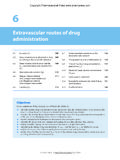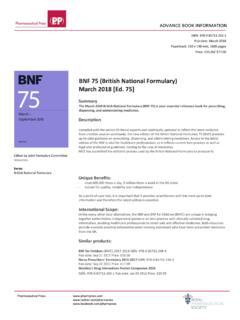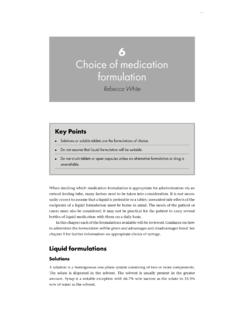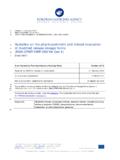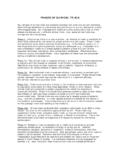Transcription of Basic pharmacokinetics - Welcome to …
1 Aims and learning outcomesPharmacokinetics is a fundamental scientific discipline that underpinsapplied therapeutics. Patients need to be prescribed appropriate medicinesfor a clinical condition. The medicine is chosen on the basis of an evidence-based approach to clinical practice and assured to be compatible withany other medicines or alternative therapies the patient may be design of a dosage regimen is dependent on a Basic under-standing of the drug use process (DUP). When faced with a patient whoshows specific clinical signs and symptoms, pharmacists must alwaysask a fundamental question: Is this patient suffering from a drug-relatedproblem? Once this issue is evaluated and a clinical diagnosis is avail-able, the pharmacist can apply the DUP to ensure that the patient is prescribed an appropriate medication regimen, that the patient under-stands the therapy prescribed, and that an agreed concordance plan using the DUP consider: Need for a drug Choice of a drug Goals of therapy Design of regimen Route Dose and frequency Duration Monitoring and review CounsellingOnce a particular medicine is chosen, the principles of clinical pharmaco-kinetics are required to ensure the appropriate formulation of drug ischosen for an appropriate route of administration.
2 On the basis of thepatient s drug handling parameters, which require an understanding of1 Basic pharmacokineticsSoraya Dhillon and Kiren Gillabsorption, distribution, metabolism and excretion, the dosage regimenfor the medicine in a particular patient can be developed. The pharmacistwill then need to ensure that the appropriate regimen is prescribed toachieve optimal efficacy and minimal toxicity. Pharmacists then ensurethat the appropriate monitoring is undertaken and that the patient receivesthe appropriate information to ensure compliance. Clinical pharmaco-kinetics is thus a fundamental knowledge base that pharmacists requireto ensure effective practice of pharmaceutical aim of this chapter is to provide the practising clinical pharma-cist with the appropriate knowledge and skills of applied clinical phar-macokinetics, which can be applied in everyday objectives for this chapter are to enable the reader to: State the rationale for using therapeutic drug monitoring (TDM) tooptimise drug therapy.
3 Identify drugs that should be routinely monitored. Define first-order and zero-order kinetics. Apply one-compartment pharmacokinetics to single and multipledosing following the intravenous and oral administration of drugs. Apply the Basic principles of interpretation of serum drug concen-trations in practice. Apply one-compartment pharmacokinetics to describe steady-stateserum drug concentrations following oral slow-release dosing. Use the method of iteration to derive individualised pharmaco-kinetic parameters from serum drug concentration data. Apply nonlinear pharmacokinetics to describe steady-state plasmaconcentrations following parenteral and/or oral phenytoin provides a mathematical basis to assess the time courseof drugs and their effects in the body. It enables the following processesto be quantified:AbsorptionDistributionMetabol ismExcretionThese pharmacokinetic processes, often referred to as ADME, determinethe drug concentration in the body when medicines are prescribed.
4 Afundamental understanding of these parameters is required to design an2 Basic pharmacokineticsappropriate drug regimen for a patient. The effectiveness of a dosageregimen is determined by the concentration of the drug in the , the concentration of drug should be measured at the site ofaction of the drug; that is, at the receptor. However, owing to inaccess-ibility, drug concentrations are normally measured in whole blood fromwhich serum or plasma is generated. Other body fluids such as saliva,urine and cerebrospinal fluid (CSF) are sometimes used. It is assumedthat drug concentrations in these fluids are in equilibrium with the drugconcentration at the should be noted that the measured drug concentrations in plasmaor serum are often referred to as drug levels, which is the term that willbe used throughout the text. It refers to total drug concentration, acombination of bound and free drug that are in equilibrium with routine clinical practice, serum drug level monitoring and opti-misation of a dosage regimen require the application of clinical pharma-cokinetics.
5 A number of drugs show a narrow therapeutic range and forthese drugs therapeutic drug level monitoring is required (Chapter 2).Table identifies drugs that should be routinely variety of techniques is available for representing the pharmaco-kinetics of a drug. The most usual is to view the body as consisting ofcompartments between which drug moves and from which eliminationoccurs. The transfer of drug between these compartments is representedby rate constants, which are considered of reactionTo consider the processes of ADME the ratesof these processes have to beconsidered; they can be characterised by two Basic underlying of reaction3 Table that should be routinely monitoredTherapeutic groupDrugsAminoglycosidesGentamicin, tobramycin, amikacinCardioactiveDigoxin, lidocaineRespiratoryTheophyllineAnticonv ulsantPhenytoin, carbamazepine, phenobarbitalOthersLithium, ciclosporinThe rate of a reaction or process is defined as the velocity at which itproceeds and can be described as either zero-orderor reactionConsider the rate of elimination of drug A from the body.
6 If the amountof the drug, A, is decreasing at a constant rate, then the rate of elimin-ation of A can be described as:where k* the zero-order rate reaction proceeds at a constant rate and is independent of theconcentration of A present in the body. An example is the elimination ofalcohol. Drugs that show this type of elimination will show accumula-tion of plasma levels of the drug and hence nonlinear reactionIf the amount of drug A is decreasing at a rate that is proportional to A,the amount of drug A remaining in the body, then the rate of eliminationof drug A can be described as:where k the first-order rate reaction proceeds at a rate that is dependent on the concentrationof A present in the body. It is assumed that the processes of ADME fol-low first-order reactions and most drugs are eliminated in this drugs used in clinical practice at therapeutic dosages willshow first-order rate processes; that is, the rate of elimination of mostdrugs will be first-order.
7 However, there are notable exceptions, forexample phenytoin and high-dose salicylates. In essence, for drugs thatshow a first-order elimination process one can show that, as the amountof drug administered increases, the body is able to eliminate the drugaccordingly and accumulation will not occur. If you double the dose you will double the plasma concentration. However, if you continue toincrease the amount of drug administered then all drugs will changefrom showing a first-order process to a zero-order process, for examplein an overdose dd*Atk 4 Basic pharmacokineticsPharmacokinetic modelsPharmacokinetic models are hypothetical structures that are used to describe the fate of a drug in a biological system following its modelFollowing drug administration, the body is depicted as a kinetically homo-geneous unit (see Figure ). This assumes that the drug achieves instant-aneous distribution throughout the body and that the drug equilibratesinstantaneously between tissues.
8 Thus the drug concentration time profileshows a monophasic response ( it is monoexponential; Figure ).It is important to note that this does not imply that the drug concentration in plasma (Cp) is equal to the drug concentration in thetissues. However, changes in the plasma concentration quantitativelyreflect changes in the tissues. The relationship described in Figure be plotted on a log Cpvs time graph (Figure ) and will thenshow a linear relation; this represents a one-compartment modelThe two-compartment model resolves the body into a central compart-ment and a peripheral compartment (see Figure ). Although these com-partments have no physiological or anatomical meaning, it is assumedthat the central compartment comprises tissues that are highly perfusedsuch as heart, lungs, kidneys, liver and brain. The peripheral compart-ment comprises less well-perfused tissues such as muscle, fat and two-compartment model assumes that, following drug adminis-tration into the central compartment, the drug distributes between thatcompartment and the peripheral compartment.
9 However, the drug doesnot achieve instantaneous distribution, equilibration, between thetwo drug concentration time profile shows a curve (Figure ),but the log drug concentration time plot shows a biphasic responsePharmacokinetic models5 Single componentkakFigure model. ka absorption rate constant (h 1), k elimination rate constant (h 1).6 Basic pharmacokineticsCpTime(a)log CpTime(b)Figure (a) Plasma concentration (Cp) versus time profile of a drug showing a one-compartment model. (b) Time profile of a one-compartment model showinglog Cpversus ink12k21kCentralPeripheralFigure model. k12, k21and kare first-order rate constants:k12 rate of transfer from central to peripheral compartment; k21 rate of transferfrom peripheral to central compartment; k rate of elimination from central compartment.(Figure ) and can be used to distinguish whether a drug shows aone- or two-compartment shows a profile in which initially there is a rapid declinein the drug concentration owing to elimination from the central compart-ment and distribution to the peripheral compartment.
10 Hence during thisrapid initial phase the drug concentration will decline rapidly from thecentral compartment, rise to a maximum in the peripheral compartment,and then a time interval (t), a distribution equilibrium is achievedbetween the central and peripheral compartments, and elimination of thedrug is assumed to occur from the central compartment. As with the one-compartment model, all the rate processes are described by models7 CpTime(a)log CpTime(b)Figure (a) Plasma concentration versus time profile of a drug showing a two-compartment model. (b) Time profile of a two-compartment model showing log Cpversus modelIn this model the drug distributes into more than one compartment and theconcentration time profile shows more than one exponential (Figure ).Each exponential on the concentration time profile describes a compart-ment. For example, gentamicin can be described by a three-compartmentmodel following a single IV dose (see Figure ).
